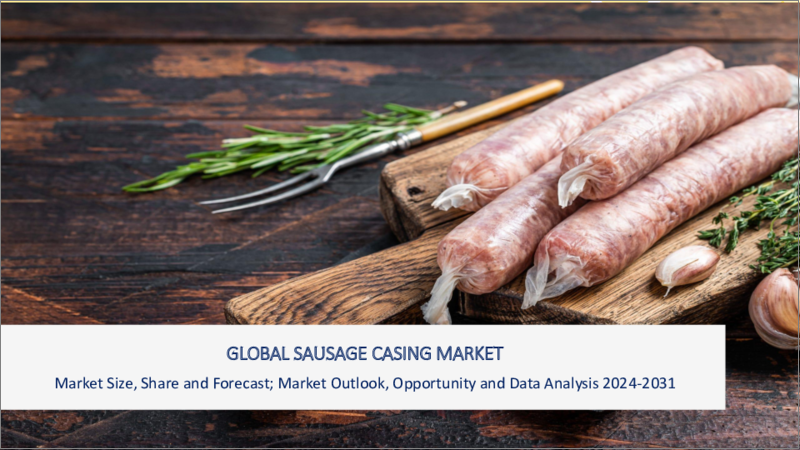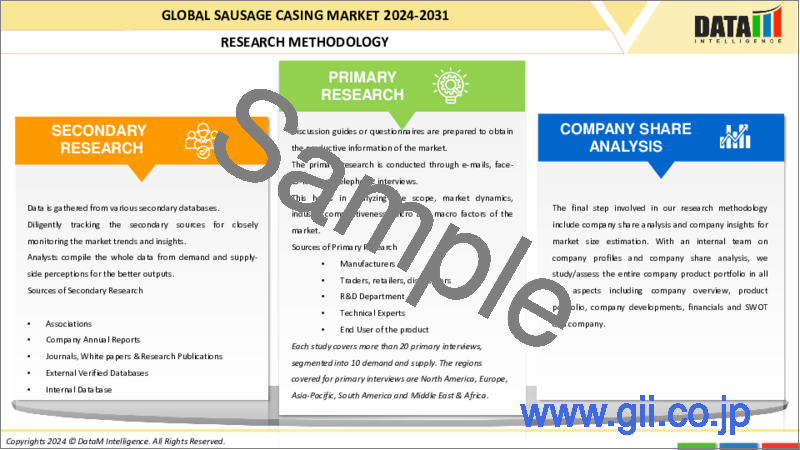|
|
市場調査レポート
商品コード
1455736
ソーセージケーシングの世界市場-2023年~2030年Global Sausage Casing Market - 2023-2030 |
||||||
カスタマイズ可能
適宜更新あり
|
|||||||
| ソーセージケーシングの世界市場-2023年~2030年 |
|
出版日: 2024年03月26日
発行: DataM Intelligence
ページ情報: 英文 201 Pages
納期: 即日から翌営業日
|
- 全表示
- 概要
- 目次
概要
ソーセージケーシングの世界市場は、2022年に28億8,000万米ドルに達し、2023-2030年の予測期間中にCAGR 4.5%で成長し、2030年には40億9,000万米ドルに達すると予測されています。
ソーセージやホットドッグなどの食肉加工品に対する消費者の嗜好の高まりが、世界のソーセージケーシング市場規模の拡大に寄与しています。食品業界におけるソーセージの人気の高まりは、ソーセージケーシングがソーセージの風味と食感を向上させるため、ソーセージケーシング市場にプラスの影響を与えます。ソーセージケーシングは、フレッシュソーセージ、スモークソーセージ、塩漬けソーセージなど様々なソーセージに幅広く応用されています。
新しく革新的な製品の発売が市場拡大の原動力となっています。ヴィーガンソーセージに対する需要の高まりが、ヴィーガンソーセージの発売を後押ししています。メーカーは植物由来のソーセージケーシングを市場に投入しています。例えば、オランダの食品エンジニアリング会社Vaessは、2022年4月にヴィーガンソーセージケーシングの発売を発表しました。
ソーセージケーシングメーカーは、ソーセージケーシングのエンドユーザーとのコミュニケーションにテクノロジーを活用し、製品の使用についてより良いサポートを提供しています。2023年4月、プラスチック製ソーセージケーシングメーカーは、消費者に迅速で快適なオンライン注文サービスを提供する新しいウェブサイトを開設しました。同メーカーは更新したウェブサイトを通じて、消費者に詳細な製品情報と使用方法を提供しています。
ダイナミクス
ソーセージ需要の増加
消費者は便利で簡単に調理できる食品を好みます。消費者の食習慣の変化と、すぐに食べられる食肉製品への高い需要が、ソーセージなどの食肉加工品の需要を押し上げています。ソーセージはヘルシーな間食の選択肢として世界市場で人気を集めています。全米ホットドッグソーセージ協会によると、2022年の米国におけるディナー用ソーセージの売上高は約12億ポンド、朝食用ソーセージの売上高は4億1,600万ポンドに達しました。
革新的な風味を持つ様々なタイプのソーセージの発売は、ソーセージの需要を増加させ、ソーセージの製造における重要な役割のため、ソーセージケーシングの需要を増加させる。ソーセージケーシングは、ソーセージの詰め物を包みます。ソーセージケーシングは、ソーセージの詰め物を包み込み、ソーセージ製品に特定の形状を与えます。ソーセージの需要の増加は、ケーシングの需要に直接影響し、市場規模を増加させる。
ソーセージケーシングの使用に対する需要の高まりは、新たな生産工場の設立を後押ししています。例えば、2022年4月、食肉製品用ケーシングの大手サプライヤーの1つであるViscofan S.A.は、イリノイ州ダンビルに製造工場を導入しました。この工場の投資により製品の生産能力が向上し、同社の事業生産拡大に貢献しています。
技術の向上
ソーセージケーシング業界における技術進歩は、世界市場にプラスの影響を与えます。装置メーカーは、産業レベルでの効率性と生産性の向上に役立つ装置を製造するために、新しい革新的な技術を採用しています。このような設備を採用することで、提供する製品の幅が広がり、市場の成長が促進されます。
2023年8月、Handtmann社は、中規模工業用ソーセージ製造業者向けの自動化システムである高性能PVLH 251 ALシステムを発表しました。この自動生産設備は、調理済みおよび乾燥ソーセージのセルロースとコラーゲンのケーシングの小分け、連結、吊り下げを処理します。コラーゲンとセルロースのケーシングの効率改善に加え、この新システムはドライソーセージやペットフード用ソーセージ製品の製造にも応用できます。
より高品質な製品製造のための新たな技術確立に関わる新機軸は、市場の需要を増大させる。2023年8月、英国のプロセスエンジニアチームは、製造されたコラーゲンソーセージの製品品質を守る新技術を開発しました。開発された新しい加工技術は、生産性を向上させ、コラーゲンソーセージのケーシングの無駄を減らすのに役立っています。
高コストと厳しい規制
ソーセージケーシングの高い製造コストは、最終製品のコストを上昇させ、市場の成長を妨げます。例えば、2023年8月、産業用ソーセージケーシングの大手サプライヤーであるKalle Groupは、原材料コストの上昇を理由にソーセージケーシングの値上げを宣言しました。ソーセージケーシングの需要急増と原材料費の上昇に対応するため、同社は巻き取り在庫の8%増と完成品の5%増を発表しました。
組織や政府は食肉加工品の製造・販売に厳しい規制を課しており、市場の拡大を抑制しています。例えば、FSSAIはソーセージに含まれる二酸化硫黄などのクラスⅡ保存料の一部を制限しています。FSISの構成員の更新は2023年5月に行われました。FSIS規則9 CFR 317.8(b)(38)および381.117(g)は、ソーセージケーシングの製品表示の承認について一定の状況を規定しています。高い規制負荷が市場成長の妨げとなっています。
目次
第1章 調査手法と調査範囲
第2章 定義と概要
第3章 エグゼクティブサマリー
第4章 市場力学
- 影響要因
- 促進要因
- ソーセージ需要の増加
- 技術の向上
- 抑制要因
- 高コストと厳しい規制
- 機会
- 影響分析
- 促進要因
第5章 産業分析
- ポーターのファイブフォース分析
- サプライチェーン分析
- 価格分析
- 規制分析
第6章 COVID-19分析
第7章 タイプ別
- 天然ケーシング
- 牛
- 羊
- 豚
- 合成ケーシング
- コラーゲン
- セルロース
- プラスチック
- 繊維
- 代替ケーシング
第8章 形態別
- チューブ入り
- プレタイド
第9章 流通チャネル別
- B2B
- B2C
- ハイパーマーケット/スーパーマーケット
- オンラインストア
- 専門店
- その他
第10章 用途別
- 非食用
- 食用
- フレッシュソーセージ
- 調理済みソーセージ
- スモークソーセージ
- 塩漬けソーセージ
- 肉ベース
第11章 エンドユーザー別
- 食品メーカー
- 家庭
- レストラン・フードサービス
- その他
第12章 地域別
- 北米
- 米国
- カナダ
- メキシコ
- 欧州
- ドイツ
- 英国
- フランス
- イタリア
- スペイン
- その他欧州
- 南米
- ブラジル
- アルゼンチン
- その他南米
- アジア太平洋
- 中国
- インド
- 日本
- オーストラリア
- その他アジア太平洋地域
- 中東・アフリカ
第13章 競合情勢
- 競合シナリオ
- 市況/シェア分析
- M&A分析
第14章 企業プロファイル
- Walton's Inc.
- 会社概要
- 製品ポートフォリオと説明
- 財務概要
- 主な発展
- Devro
- Weschenfelder Direct Ltd
- Lemproducts
- ALMOL CASING PTY LTD
- Viscofan
- DAT-Schaub Group
- Saria Se
- MCJ Casings
- Combinatie Teijsen V.D. Hengel
第15章 付録
Overview
Global Sausage Casing Market reached US$ 2.88 billion in 2022 and is expected to reach US$ 4.09 billion by 2030, growing with a CAGR of 4.5% during the forecast period 2023-2030.
Increasing consumer preference towards processed meat products, such as sausages and hotdogs, helps expand the global sausage casings market size. The growing popularity of sausages in the food industry positively influences the sausage casing market, as sausage casings improve the flavor and texture of sausages. The sausage casings have wide applications in various sausages, including fresh, smoked and cured sausages.
New and innovative product launches boost the fuel the market expansion. Rising demand for vegan sausages is driving the launches of vegan sausages. Manufacturers are introducing plant-based sausage casing into the market. For instance, Vaess, a Netherlands-based food engineering company, announced the launch of a vegan sausage casing, in April 2022.
Sausage casings manufacturers are using technology to communicate with the end users of the sausage casings for better assistance on the use of the product. In April 2023, Plastic Sausage Casing, a manufacturer of plastic sausage casings, created a new website that provides fast and comfortable online ordering services to consumers. The manufacturer provides consumers with detailed product information and usage instructions through the updated website.
Dynamics
Increasing Demand for Sausages
Consumers prefer convenient and easy-to-cook food choices. The changing consumer food habits and high demand for ready-to-eat meat products boost the demand for processed meat products such as sausages. Sausages are gaining popularity as a healthy meat-snacking option in the global market. According to the National Hot Dog & Sausage Council, in 2022, the sales of dinner sausage were nearly 1.2 Billion pounds and breakfast sausage sales reached 416 million pounds in U.S.
The launch of various types of sausages with innovative flavors increases the sausage demand, in turn increasing the demand for sausage casing, due to its key role in the production of sausage. The sausage casings enclose the filling of a sausage. They hold and provide a specific shape to the sausage product. The increasing demand for sausages, directly influences the demand for casings, increasing the market size.
The rising demand for the use of sausage casings is driving the establishment of new production production plants. For instance, in April 2022, Viscofan S.A., one of the leading suppliers of casings for meat products, introduced a manufacturing plant in Danville, Illinois. The plant's investment drives the production capacity of the products, helping the company to expand its business production.
Technological Improvements
The technological advancement in the sausage casings industry positively influences the global market. The equipment manufacturers adopt new and innovative techniques to produce the equipment that help in improving efficiency and productivity at the industrial level. Adopting these equipments increases the product range offering, driving the market growth.
In August 2023, Handtmann laucnhed a high-performance PVLH 251 AL system, an automated system for medium-scale industrial sausage producers. The automated production facility handles portioning, linking and hanging cellulose and collagen casing in cooked and dried sausages. In addition to improving the efficiency in the collagen and cellulose casings, the new system is applicable for dry sausages and producing sausage products for pet food.
The new innovation involved in establishing new techniques for better quality product production increases the market demand. In August 2023, a UK team of process engineers developed a new technique that protects the product quality of the manufactured collagen sausage. The new processing technology developed helps improve productivity and reduce the wastage of the collagen sausage casings.
High Coss and Stringent Regulations
The high production costs of the sausage casings increase the cost of final products, hindering market growth. For instance, in August 2023, Kalle Group, a leading industrial sausage casing supplier, declared an increase in the prices for sausage casings, due to the increasing raw material costs. To keep up with the rapidly increasing demand for sausage casings with the increasing raw material costs, the company announced an 8 % increase in the reeling stock and a 5% increase in the finished product.
Organisations and governments impose stringent regulations on producing and selling processed meat products, restraining market expansion. For instance, FSSAI has restricted some of the class II preservatives, such as sulphur dioxide, in the sausages. Constituent update of FSIS was done in May 2023. FSIS regulations 9 CFR 317.8(b)(38) and 381.117(g) provided certain circumstances for the approval of product labelling of sausage casings. The high regulatory load hamper the market growth.
Segment Analysis
The global sausage casing market is segmented based on type, form, distribution channel, application, End-User and region.
Convenience and Versatility
The global sausage casing market is segmented based on type into natural, synthetic and alternative casings. The artificial casings segment held the largest global market share due to its simple use and wide availability. The strength and elasticity provided by the artificial sausage casings positively drive segment growth. The artificial sausage casings are sub-segmented into collagen, cellulose, plastic and fibres.
Following the sustainability trend, manufacturers are introducing sustainable sausage casings. In April 2021, Viskase Companies Inc., a global corporation that supplies casings for processed meat products, such as sausages, unveiled sustainable EcoLine plastic casings. The company introduced Visflex, Vismax and Vislon Casings, which contain more than 80% chemically recycled plastic. More than 90% of chemically recycled plastic is present in Polyjax Casings.
The new acquisitions among the major market players help in expanding the market on a global scale. For instance, in August 2022, DCW Casing, a manufacturer of various sausage casings, was acquired by the Danish Crown's subsidiary, DAT-Schaub. The acquisition helps expand the company's product portfolio in the collagen casing product line.
Geographical Penetration
Increased Demand for Processed Meat Products
Europe dominated the global sausage casings market, due to its high demand for processed meat products. The region's increasing popularity for processed meat products, such as sausages, in turn, increases the demand for the important ingredient of the product, sausage casings. Europeans prefer sausages over traditional meat because of the convenience and longer shelf life.
The high demand for the sausages increases the market demand for sausage casings. Countries like Germany, Italy and the Netherlands had the largest market shares in the region. With the high consumption rates, Germany dominated the market. In 2021, Germany accounted for a high sausage consumption range with 21kg per person.
The region has applied advanced technology in manufacturing sausage casings. For instance, Pooshesh Tehran Navid Co. company developed plastic sausage casings in Germany, through the application of the latest technology of polymer extrusion. The presence of key market players such as Viscofan S.A., Devro and DAT-Schaub, which manufacture sausage casings, helps in the wide expansion of the market in this region.
Competitive Landscape
The major global players in the market include Walton's Inc., Devro, Weschenfelder Direct Ltd., Lemproducts, ALMOL CASING PTY LTD, Viscofan, DAT-Schaub Group, Saria Se, MCJ Casings and Combinatie Teijsen V.D. Hengel.
COVID-19 Impact Analysis
The outbreak of the COVID-19 pandemic had both positive and negative impacts on the global sausage casing market. Food processing industries are hugely impacted due to the lockdown restrictions by the governments. The processing industries halt their production and distribution activities. Poor supply chain activities reduced the availability of required resources to produce products.
The scarcity of raw materials and labor shortages resulted in low production rates. The disrupted distribution channel activities interrupted the product distribution to the End-User segments. The shutdown of food service sectors and restaurants with wide End-User applications of the product use for their sausage sales decreased the market size.
The change in consumer food patterns and high-snacking habits contributed to increased consumption of processed meat products, positively impacting the sausage casing market. An increased demand for smoked and cured sausages, which are convenient and ready-to-use products, raised the market demand. In addition, the increased use, accessibility and popularity of the e-commerce sector and the wide availability of these products in online sales increased the market demand.
Russia- Ukraine War Impact
The Russia-Ukraine war had a negative impact on many industrial sectors, including food. The scarcity of raw materials, reduced workforce, and distribution channel disruption affected the processed food products market growth, affecting the sausage casing market. The war created import and export trade disruptions, resulting in economic disturbances. The political and economic uncertainty created due to the war had a negative impact on the sausage casing market.
By Type
- Natural Casings
- Cattle
- Sheep
- Pig
- Synthetic Casing
- Collagen
- Cellulose
- Plastic
- Fibers
- Alternative Casing
By Form
- Tubed
- Pretied
By Distribution Channel
- Business to Business
- Business to Consumers
- Hypermarkets/supermarkets
- Online stores
- Specialty stores
- Others
By Application
- Non-Edible
- Edible
- Fresh Sausages
- Pre-Cooked Sausages
- Smoked Sausages
- Cured Sausages
- Meat-Based
By End-User
- Food Manufacturers
- Household
- Restaurants and Food Service
- Others
By Region
- North America
- U.S.
- Canada
- Mexico
- Europe
- Germany
- UK
- France
- Italy
- Russia
- Rest of Europe
- South America
- Brazil
- Argentina
- Rest of South America
- Asia-Pacific
- China
- India
- Japan
- Australia
- Rest of Asia-Pacific
- Middle East and Africa
Key Developments
- In May 2023, Danish Crown subsidiary DAT-Schaub acquired SELO companies by taking over 70% of the company stakes. Through the acquisition, the company increased their sales of artificial casings by expanding the market in the Benelux region.
- In December 2022, SARIA, a German food manufacturer, acquired Devro Plc, a Scottish sausage casing-producing company. The acquisition helps SARIA company expand their collagen-based sausage casings product in the market.
- In November 2022, DAT-Schaub, the Danish Crown's subsidiary company, acquired Insuban Ltda, Indexna S.A., Tricolsa S.A.S., and ESB. Through these acquisitions, the company expanded its business line in South America.
Why Purchase the Report?
- To visualize the global sausage casing market segmentation based on type, form, distribution channel, application, End-User and region, as well as understand key commercial assets and players.
- Identify commercial opportunities by analyzing trends and co-development.
- Excel data sheet with numerous data points of sausage casing market-level with all segments.
- PDF report consists of a comprehensive analysis after exhaustive qualitative interviews and an in-depth study.
- Product mapping available as excel consisting of key products of all the major players.
The global sausage casing market report would provide approximately 77 tables, 75 figures and 201 Pages.
Target Audience 2023
- Manufacturers/ Buyers
- Industry Investors/Investment Bankers
- Research Professionals
- Emerging Companies
Table of Contents
1.Methodology and Scope
- 1.1.Research Methodology
- 1.2.Research Objective and Scope of the Report
2.Definition and Overview
3.Executive Summary
- 3.1.Snippet by Type
- 3.2.Snippet by Form
- 3.3.Snippet by Distribution Channel
- 3.4.Snippet by Application
- 3.5.Snippet by End-User
- 3.6.Snippet by Region
4.Dynamics
- 4.1.Impacting Factors
- 4.1.1.Drivers
- 4.1.1.1.Increasing Demand for Sausages
- 4.1.1.2.Technological Improvements
- 4.1.2.Restraints
- 4.1.2.1.High Cost and Stringent Regulations
- 4.1.3.Opportunity
- 4.1.4.Impact Analysis
- 4.1.1.Drivers
5.Industry Analysis
- 5.1.Porter's Five Force Analysis
- 5.2.Supply Chain Analysis
- 5.3.Pricing Analysis
- 5.4.Regulatory Analysis
6.COVID-19 Analysis
- 6.1.Analysis of COVID-19
- 6.1.1.Scenario Before COVID
- 6.1.2.Scenario During COVID
- 6.1.3.Scenario Post COVID
- 6.2.Pricing Dynamics Amid COVID-19
- 6.3.Demand-Supply Spectrum
- 6.4.Government Initiatives Related to the Market During Pandemic
- 6.5.Manufacturers Strategic Initiatives
- 6.6.Conclusion
7.By Type
- 7.1.Introduction
- 7.1.1.Market Size Analysis and Y-o-Y Growth Analysis (%), By Type
- 7.1.2.Market Attractiveness Index, By Type
- 7.2.Natural Casing
- 7.2.1.Introduction
- 7.2.2.Market Size Analysis and Y-o-Y Growth Analysis (%)
- 7.2.3.Cattle
- 7.2.4.Sheep
- 7.2.5.Pig
- 7.3.Synthetic Casing
- 7.3.1.Collagen
- 7.3.2.Cellulose
- 7.3.3.Plastic
- 7.3.4.Fibers
- 7.4.Alternative Casing
8.By Form
- 8.1.Introduction
- 8.1.1.Market Size Analysis and Y-o-Y Growth Analysis (%), By Form
- 8.1.2.Market Attractiveness Index, By Form
- 8.2.Tubed
- 8.2.1.Introduction
- 8.2.2.Market Size Analysis and Y-o-Y Growth Analysis (%)
- 8.3.Pretied
9.By Distribution Channel
- 9.1.Introduction
- 9.1.1.Market Size Analysis and Y-o-Y Growth Analysis (%), By Distribution Channel
- 9.1.2.Market Attractiveness Index, By Distribution Channel
- 9.2.Business to Business
- 9.2.1.Introduction
- 9.2.2.Market Size Analysis and Y-o-Y Growth Analysis (%)
- 9.3.Business to Consumers
- 9.3.1.Hypermarkets/supermarkets
- 9.3.2.Online stores
- 9.3.3.Specialty stores
- 9.3.4.Others
10.By Application
- 10.1.Introduction
- 10.1.1.Market Size Analysis and Y-o-Y Growth Analysis (%), By Application
- 10.1.2.Market Attractiveness Index, By Application
- 10.2.Non-Edible
- 10.2.1.Introduction
- 10.2.2.Market Size Analysis and Y-o-Y Growth Analysis (%)
- 10.3.Edible
- 10.3.1.Fresh Sausages
- 10.3.2.Pre-Cooked Sausages
- 10.3.3.Smoked Sausages
- 10.3.4.Cured Sausages
- 10.3.5.Meat-Based
11.By End-User
- 11.1.Introduction
- 11.1.1.Market Size Analysis and Y-o-Y Growth Analysis (%), By End-User
- 11.1.2.Market Attractiveness Index, By End-User
- 11.2.Food Manufacturers
- 11.2.1.Introduction
- 11.2.2.Market Size Analysis and Y-o-Y Growth Analysis (%)
- 11.3.Household
- 11.4.Restaurants and Food Service
- 11.5.Others
12.By Region
- 12.1.Introduction
- 12.1.1.Market Size Analysis and Y-o-Y Growth Analysis (%), By Region
- 12.1.2.Market Attractiveness Index, By Region
- 12.2.North America
- 12.2.1.Introduction
- 12.2.2.Key Region-Specific Dynamics
- 12.2.3.Market Size Analysis and Y-o-Y Growth Analysis (%), By Type
- 12.2.4.Market Size Analysis and Y-o-Y Growth Analysis (%), By Form
- 12.2.5.Market Size Analysis and Y-o-Y Growth Analysis (%), By Distribution Channel
- 12.2.6.Market Size Analysis and Y-o-Y Growth Analysis (%), By Application
- 12.2.7.Market Size Analysis and Y-o-Y Growth Analysis (%), By End-User
- 12.2.8.Market Size Analysis and Y-o-Y Growth Analysis (%), By Country
- 12.2.8.1.U.S.
- 12.2.8.2.Canada
- 12.2.8.3.Mexico
- 12.3.Europe
- 12.3.1.Introduction
- 12.3.2.Key Region-Specific Dynamics
- 12.3.3.Market Size Analysis and Y-o-Y Growth Analysis (%), By Type
- 12.3.4.Market Size Analysis and Y-o-Y Growth Analysis (%), By Form
- 12.3.5.Market Size Analysis and Y-o-Y Growth Analysis (%), By Distribution Channel
- 12.3.6.Market Size Analysis and Y-o-Y Growth Analysis (%), By Application
- 12.3.7.Market Size Analysis and Y-o-Y Growth Analysis (%), By End-User
- 12.3.8.Market Size Analysis and Y-o-Y Growth Analysis (%), By Country
- 12.3.8.1.Germany
- 12.3.8.2.U.K.
- 12.3.8.3.France
- 12.3.8.4.Italy
- 12.3.8.5.Spain
- 12.3.8.6.Rest of Europe
- 12.4.South America
- 12.4.1.Introduction
- 12.4.2.Key Region-Specific Dynamics
- 12.4.3.Market Size Analysis and Y-o-Y Growth Analysis (%), By Type
- 12.4.4.Market Size Analysis and Y-o-Y Growth Analysis (%), By Form
- 12.4.5.Market Size Analysis and Y-o-Y Growth Analysis (%), By Distribution Channel
- 12.4.6.Market Size Analysis and Y-o-Y Growth Analysis (%), By Application
- 12.4.7.Market Size Analysis and Y-o-Y Growth Analysis (%), By End-User
- 12.4.8.Market Size Analysis and Y-o-Y Growth Analysis (%), By Country
- 12.4.8.1.Brazil
- 12.4.8.2.Argentina
- 12.4.8.3.Rest of South America
- 12.5.Asia-Pacific
- 12.5.1.Introduction
- 12.5.2.Key Region-Specific Dynamics
- 12.5.3.Market Size Analysis and Y-o-Y Growth Analysis (%), By Type
- 12.5.4.Market Size Analysis and Y-o-Y Growth Analysis (%), By Form
- 12.5.5.Market Size Analysis and Y-o-Y Growth Analysis (%), By Distribution Channel
- 12.5.6.Market Size Analysis and Y-o-Y Growth Analysis (%), By Application
- 12.5.7.Market Size Analysis and Y-o-Y Growth Analysis (%), By End-User
- 12.5.8.Market Size Analysis and Y-o-Y Growth Analysis (%), By Country
- 12.5.8.1.China
- 12.5.8.2.India
- 12.5.8.3.Japan
- 12.5.8.4.Australia
- 12.5.8.5.Rest of Asia-Pacific
- 12.6.Middle East and Africa
- 12.6.1.Introduction
- 12.6.2.Key Region-Specific Dynamics
- 12.6.3.Market Size Analysis and Y-o-Y Growth Analysis (%), By Type
- 12.6.4.Market Size Analysis and Y-o-Y Growth Analysis (%), By Form
- 12.6.5.Market Size Analysis and Y-o-Y Growth Analysis (%), By Distribution Channel
- 12.6.6.Market Size Analysis and Y-o-Y Growth Analysis (%), By Application
- 12.6.7.Market Size Analysis and Y-o-Y Growth Analysis (%), By End-User
13.Competitive Landscape
- 13.1.Competitive Scenario
- 13.2.Market Positioning/Share Analysis
- 13.3.Mergers and Acquisitions Analysis
14.Company Profiles
- 14.1.Walton's Inc.
- 14.1.1.Company Overview
- 14.1.2.Product Portfolio and Description
- 14.1.3.Financial Overview
- 14.1.4.Key Developments
- 14.2.Devro
- 14.3.Weschenfelder Direct Ltd
- 14.4.Lemproducts
- 14.5.ALMOL CASING PTY LTD
- 14.6.Viscofan
- 14.7.DAT-Schaub Group
- 14.8.Saria Se
- 14.9.MCJ Casings
- 14.10.Combinatie Teijsen V.D. Hengel
LIST NOT EXHAUSTIVE
15.Appendix
- 15.1.About Us and Services
- 15.2.Contact Us






